Abstract
During the sinking process, overflow generates an entrainment phenomenon, accompanied by the occurrence, development, and dissipation of vortices. In this paper, particle image velocimetry (PIV) technology is used to measure the flow fields of overflow sinking, invasion, and mixing. In order to quantitatively analyze the mixing and flow processes during the sinking of the overflow, vorticity, turbulence dissipation, Froude number, local Richardson number, and entrainment coefficient are calculated. In a stratified environment, the overflow entrains the environment fluid of lower density to reach a terminal height where their density equals that of their surroundings and then spread out horizontally. The experimental results show the terminal depth is related to the density of the overflow. The lower the density, the smaller the terminal depth. The turbulent dissipation mainly occurs in the area along the slope and during the process of invading flow to the surrounding. The extreme of the turbulent dissipation is corresponding to the maximum velocity shear and vorticity. At the point where the overflow crosses the sill and at the front end of the overflow, there will be a more obvious phenomenon of entrainment. The entrainment parameter is positively correlated with the density of overflow. These preliminary results would require additional experimental validation and data observation in order to assess their relevance for realistic flow regimes.
1. Introduction
Overflow plays an important role in the generation of deep-sea thermohaline circulation. For example, in the Nordic Sea between the North Atlantic and the Arctic Ocean, 3/4 of the Atlantic water entering will be converted into high-density overflow water [1], sinking into the North Atlantic Deep Water (NADW) and ultimately contributing to the Atlantic meridional overturning circulation [2]. It is considered to be the main driving force of global thermohaline circulation [3,4], thereby affecting global ocean circulation and climate change [5,6,7,8]. Entrainment between gravity flow and its surrounding fluid is directly related to local mixing caused by turbulent boundaries. The shear between the overflow and the quiescent fluid lying above the current can produce instability (e.g., Kelvin Helmholtz) and vertical mixing [9,10]. Therefore, describing the mixing properties of stratified turbulence is important to the understanding of geophysical flows [11]. Modeling of the overflow relies on understanding and characterizing the mixing and entrainment of the ambient fluid into the denser gravity current [12,13]. The Richardson number (Ri) is a good measure of the stability of the shear layer, and when it is less than 0.25, shear instability will occur [14]. It can be used to understand the entrainment phenomenon in gravity flow by calculating the gradient Ri and local volume Ri [11]. The overflow undergoes a series of spatial and temporal changes during the process of terrain subsidence, resulting in varying degrees of mixing at the interface with the layered environmental water, and continuously exchanges material and energy between the different water to form new deep overflow water.
Numerical simulations and observations indicate that terrain-triggered convective overturning dominates the mixing of the descending gravity flow [15,16,17]. Investigations of hydraulically controlled overflow in deep-water channels are generally based on indirect indications following from the theory: channel width in its narrowest parts and sill height, density stratification that restructures when the current overflows the threshold, correspondence of measured velocities and transports in the critical section to the velocities and transports predicted by the theory. Such a theory is well developed for the case of a two-layer inviscid incompressible fluid [18,19,20,21]. The different slopes of the terrain also affect the velocity of the overflow and the mixing between water bodies during the sinking process. Therefore, the anisotropy of the deep ocean overflow may also be due to the different topography of the seabed [22]. The replenishment of deep water by overflow can cause compensatory flow in the upper layer. The Froude number (Fr) in flow may rely on the details of stratification and shear profiles as well as the structures of rotational and transverse flow [23,24]. The characteristics of overflow greatly depend on the Fr based on upper stratification and upper flow velocity [25]. The descending flow accelerates because of the difference in the height of the sill and its foot. The Fr of this flow was greater than 1. Near the foot of the slope, the kinetic energy of the flow becomes insufficient to continue moving in this regime. The flow slows down, and strong mixing and warming of the bottom water occurs due to the exchange with the surrounding waters. This hydrodynamic phenomenon is called supercritical hydraulically controlled flow [26].
In this paper, we present experimental measurements of a gravity current, motivated by characterizing natural oceanic overflows. By changing the density and velocity of the inflow and the slope of the sill, the turbulent mixing caused by interface instability during the overflow sinking process is observed. The influence of different factors on the sinking pattern and interlayer mixing of the overflow along the slope surface is studied, as well as the vortex generation law of different water layers. The correlation between the corresponding turbulent dissipation rates and the dimensionless numbers, such as the Froude number and the Ri, is calculated to explore the impact of these factors on the turbulent mixing process of overflow.
2. Experimental Setup
A schematic of the experimental facility used to measure the overflow is shown in Figure 1. The central part of the facility is a water tank, with dimensions of 600 mm (length), 48 mm (width), and 200 mm (height). On the left side of the tank is the simulated seabed terrain, including curved basins, sill, and terrain with different slopes. For the convenience of observation and measurement, the water tank is made of acrylic material with a 5 mm thickness. To simulate stratification in the ocean, a double cylinder method was used to place layered water. High-density saline water is pumped through a peristaltic pump from the short horizontal edge at the left end (155 mm high), and then the saline water will pile up in the basin and overflow from the ridge at the end. To explore the effects of different terrains, experimental setups with slopes angles of 30°, 45°, and 60° are used.
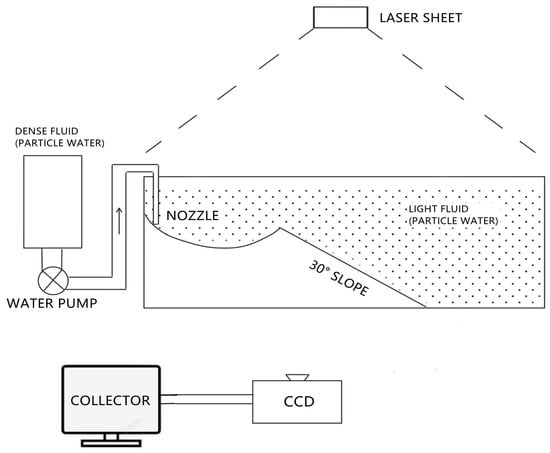
Figure 1.
Schematic of the experimental facility.
Seven experiment groups (Table 1) are set up with overflow water densities of 1040, 1050, and 1060 kg/m3, respectively, with water injection rates of 0.55, 0.65, 0.75 mL/s, and slope angles of 30°, 45°, and 60° for the terrain control. For the convenience of labeling, the experiments are divided into three major groups, where group (a) corresponds to water injection density from small to large, group (b) corresponds to water injection rate from small to large, and group (c) corresponds to terrains slope from small to large.

Table 1.
Experimental setup groups.
Particle image velocimetry (PIV) is used to obtain the flow velocity field information [27]. The measured flow field is illuminated by a pulse laser with a thickness of 532 nm and 4 W constant energy output, and a 5-megapixel high-speed CCD camera was placed directly above the middle of the device at a frequency of 20 Hz for a continuous 5 min shooting with a field of view of 45 cm × 14.5 cm (Figure 2).
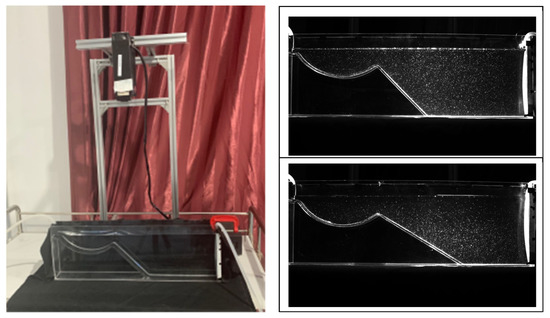
Figure 2.
The velocity field of overflow measured by PIV.
3. Data and Method
The fundamental problem of mixing and entrainment in gravity currents has roots in theory and experiments [9,28,29], which motivated detailed experimental characterization of stably stratified shear flows [30,31]. In this paper, the following parameters are mainly used in the data processing. The buoyancy frequency N2 is the natural frequency of the vertical oscillation of fluid parcels in a continuously stratified fluid. , where, acceleration due to gravity, is in situ density of each layer, is the density gradient. The Richardson number provides non-dimensional measures of the relative importance of inertia to buoyancy to shear (potential to kinetic energy) and usually would be used to characterize the impact of flow velocity on fluid stability. There are several ways to define this parameter [11]. Inside the mixing zone, mixing is produced by an instability whose strength depends on the magnitude and structure of the shear in the z-direction of the streamwise velocity component [32], as measured by the gradient Richardson number: , where, is the velocity gradient. The Froud number, , is used to characterize the impact of density changes on mixing degree, where, is the average flow velocity of the layer where the overflow is located, , is the reduced gravity, and are density in the lower and upper layers, is the thickness of the layer.
When using the double-cylinder method for layered water paving, the rolling speed of the pump is constant. Due to the influence of the terrain of the experimental tank, the density change in the upper water layer is smaller than that in the lower water layer. A handheld conductivity meter is used to measure the salinity with a depth of 1 cm as an interval. The water depth on the right side of the device is 16.5 cm, and the measurement starting point is 1 cm below the surface. Figure 3 shows the density profile and corresponding buoyancy frequency N2 in group (a2). There are slight differences in the density profiles of experiments, so the images of other groups are omitted.

Figure 3.
Density vertical profile and corresponding N2 of experiment (group a2). The black line is , and the red line is the density of the layered water.
The rate of fluid entrainment is an important parameter in many inhomogeneous turbulent flows including gravity currents and oceanic overflows. Entrainment is often parameterized using an entrainment parameter E, which is a strong function of Ri. There have been significant efforts to measure the Ri dependence of E using laboratory and field experiments [11,28,31,33,34]. Here, E is defined as follows [29]:
It should be noticed that the formula is only applicable for Ri < 0.8 and takes 0 for Ri ≥ 0.8 [29].
The stronger the velocity shear, the greater the velocity difference between layers, and the stronger the instability, which is usually considered a reliable predictive factor for the occurrence of instability. The early works include research on eddy formation and mixing structure [35,36,37], the effects of rotation [38,39,40], and the development of the gravity current front and its speed [41]. Turbulent dissipation in the flow field is calculated by PIV-measured results. Considering the characteristics of the overflow, the corresponding mean flow velocity is obtained for the entire layer where each point is located, the pulsation velocity is obtained by subtracting the corresponding mean flow rate from the instantaneous velocity of each point, and then the dissipation rate is calculated by the spatial distribution of the pulsation velocity. Newtonian fluid dissipation is defined as [42]:
where is the kinematic viscosity coefficient. is the strain rate tensor, and double indices indicate summation over all three directions. is the velocity gradient. PIV can only obtain two-dimensional spatial velocity distribution, under the assumption of incompressible fluid and turbulent isotropy, Equation (2) can be simplified by using a continuity equation to obtain the computational formula of turbulent dissipation:
where u and w are the pulsation velocities in the horizontal and vertical directions.
4. Results
4.1. Velocity Fields
The momentum flux at the source can be extended to the case of plumes or buoyant jets, for which the driving energy comes from gravity acting continuously on the small density difference between the plume and its surroundings [43]. Laboratory observations have shed on the mechanism of turbulent entrainment [29]. At the beginning of the ascent, light plumes carry dense fluids and reach the final elevation with the same density as the surrounding environment, and then expand horizontally. The plume in a layered environment will stop at a finite height, which depends on two parameters: buoyancy flux and N2 [9]. A steady turbulent gravity current flowing along a slope can be regarded as a special case of a two-dimensional plume. It is driven by the component of gravity acting down the slope [44].
Figure 4 shows the temporal variation of the flow field during the overflow process of group (a2). The overflow flows horizontally due to inertia after passing the sill. However, due to the high density of the overflow water itself, there is a downward vertical movement. Therefore, when the overflow water moves along the terrain slope, there is always a horizontal diffusion. Overflow water does not move continuously along the slope toward the bottom. When the overflow water sinks while mixing and reaches a water layer, where the buoyancy and gravity are equivalent, the flow basically achieves a stable state (about 300.0 s). The vertical movement becomes an oscillation near the layer, and the overflow water maintains a horizontal movement along the layer. This is consistent with the previous research [29,43,44].
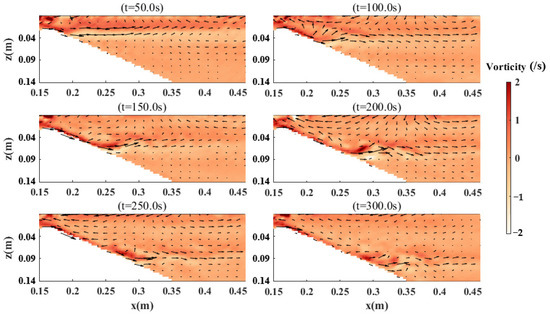
Figure 4.
The temporal variation of the flow field in group (a2).
The flow fields of the three groups (Figure 5) show the magnitude of the velocity and the depth of the overflow in the quasi-steady state. In group (a), the densities of the overflow are different. The overflow in group (a1) starts to move horizontally at a depth of 5 cm, and the horizontal velocity is much higher than that of group (a2) and (a3). This is because the density of the overflow is the smallest in group (a1), the vertical movement distance is short, and the kinetic energy dissipation is the smallest. Therefore, the maximum velocity is maintained in the horizontal direction. With the highest density in group (a3), the overflow can reach the bottom of the slope and then move to the right along the bottom, but the velocity is the minimum. Comparing group (b) with different injection rates, the group (b1) with lower velocity reached a shallower depth of overflow compared to the other two groups. In group (b3), although the flow velocity is high after passing the sill, its disturbance in each water layer is large. Therefore, momentum rapidly decays under the action of mixing and dissipation. The flow velocity to the bottom is smaller than that of group (b2). The flow fields with different slope terrains are shown in Figure 5c. The slope angle in group (c3) is the largest, and the shear of overflow velocity is the most severe. Furthermore, the compensation flow near the overflow in group (c2) is more pronounced than in the other two groups. It can be seen that the impact of slope on overflow is more complex and requires more detailed experiments to explore.
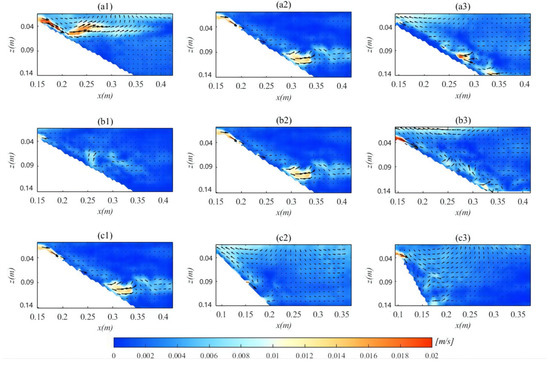
Figure 5.
Flow field distribution of three groups of experiments. Group (a) from left to right corresponds to water injection density from small to large, group (b) corresponds to water injection velocity from small to large, and group (c) corresponds to slope from small to large.
4.2. Vorticity Fields and Turbulent Dissipation
To further study the mixing between the overflow water and the ambient water, this paper observes the evolution of the mixing zones caused by KH instability through typical vorticity fields and turbulent dissipation.
The spatial distribution of the vorticity of the overflow water sinking to the middle and lower layers in Figure 6 shows that the overflow continuously generates vortices during the sinking process. When the overflow sinks, the shear velocity at the front end is the highest, resulting in larger vortices. The positive vorticity corresponds to the strong mixing related to the KH instability. Due to the stability of the layered environment, momentum and vorticity will not dissipate rapidly after reaching the specific water layer. The gravity flow under the metastability flow field will oscillate at its stable flowing water layer, resulting in the phenomenon of alternating positive and negative vorticity. And transfer process from large vortices to small vortices can be observed. Therefore, the attenuation effect of KH instability on shear not only occurs in the process of downward flow, but also occurs at the interfaces of the specific water layer. It is difficult to observe the vortices on the right side because the turbulent dissipation caused by the frictional effect makes the intrusion flow velocity decrease.
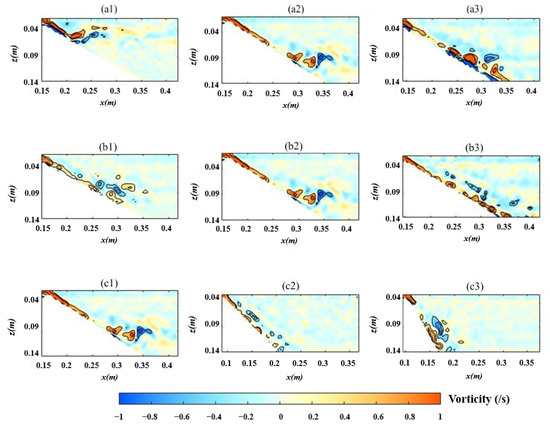
Figure 6.
Vorticity distribution of three groups of experiments. Group (a) from left to right corresponds to water injection density from small to large, group (b) corresponds to water injection speed from small to large, and group (c) corresponds to slope from small to large.
It can be observed that strong dissipation occurs when sinking along the slope (Figure 7), while there is almost dissipation elsewhere. This indicates that the slope is the main area where turbulent dissipation of overflow kinetic energy occurs. When the overflow sinks to a certain layer, the vortex generated during the entrainment process can also be transferred to the right. But, as the large vortex breaks down into small vortices, turbulent dissipation tends to zero. Comparing the experiments in Figure 7 group (a), the higher the density of the overflow, the stronger the turbulent dissipation generated during its sinking along the slope. This is because the main source of turbulent dissipation in the sinking process is divided into two parts, the buoyancy flux term generated by the larger vertical density gradient at the front of the sinking overflow, and the shear instability caused by the velocity gradient between the overflow and the background flow. When the overflow with higher density passes through the ridge, the density difference between it and the background fluid is greater, resulting in a larger density disturbance term in the buoyancy flux. According to the turbulent entrainment mechanism, the overflow with a higher density is easier to reach the bottom, which is consistent with group (a), as shown in Figure 7.
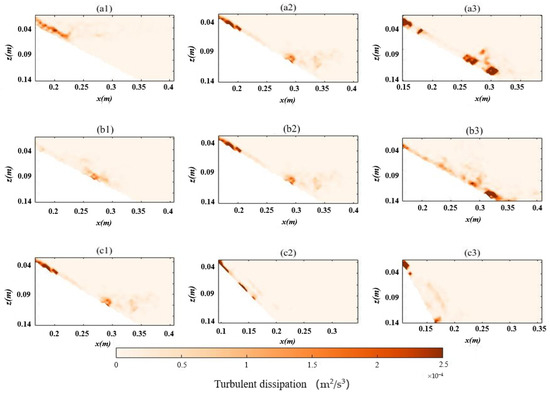
Figure 7.
Spatial distribution of turbulent dissipation for the three groups of experiments. Group (a) from left to right corresponds to water injection density from small to large, group (b) corresponds to water injection velocity from small to large, and group (c) corresponds to slope from small to large.
In Figure 7, group (b) shows that the greater the inject velocity of the overflow, the greater the turbulent dissipation, which is consistent with the velocity field and vorticity field. But group (c) shows different patterns. When the density and velocity of the overflow are constant and the terrain slope is changed, the difference in turbulence dissipation is not significant. Because the total turbulent dissipation generated by velocity shear includes the influence of slope length.
The turbulent dissipation field (Figure 7) shows that each group of experiments has a large turbulent dissipation after crossing the sill, where there is a large velocity gradient and density gradient, and the instability caused by the shear between the gravity flow and the ambient water is the strongest. Another location for the extreme value of turbulent dissipation is the water layer with a density equivalent to that of overflow, where the direction of overflow velocity changes, resulting in significant velocity shear. Therefore, turbulent dissipation will once again attain its extreme value. Corresponding to the velocity field and vorticity field, the momentum keeps decreasing due to mixing and dissipation.
4.3. Entrainment Phenomena and Water Intrusion
Entrainment takes place through the engulfment of external, non-turbulent fluid by the large eddies of the flow, followed by viscous diffusion of vorticity [44]. During the sinking process of overflow, turbulent entrainment produces the mixing of high-density overflow water with a low-density background field. The density of the overflow water itself reduces with the mixing so that it cannot sink to the corresponding layer according to the original density and, instead, flow in the less dense layer. The flow velocity of the intrusive layer is higher than the background flow velocity of the upper and lower layers, so vortices generated by velocity shear will occur above and below the interface of the extended layer.
In this paper, we use the double-cylinder method to place the ambient water. Because of the slope, the volume of injected water in each layer is different which leads to the different density of each layer. The water density at the bottom of the device varies slightly. As the volume of water injected into the upper layer increases, the density of each layer changes markedly. Therefore, it is not strictly linear stratification. By measuring the salinity of the background water, there are 14 water layers in the background water. The layer with the highest average velocity is selected as the layer that generates intrusion flow after overflow reaches a certain depth. The Fr number and Ri number at this layer are calculated. Further, the two dimensionless numbers of intrusion layers under different experimental conditions are time-averaged separately, and the following results are obtained (Table 2).

Table 2.
Froude numbers and Richardson numbers at different densities and rotational speeds.
The results show that the overflow intrusion layer with higher density corresponds to a larger number of Fr, but its change slows down as the density increases. The larger the flow velocity, the smaller the Ri corresponding to the overflow intrusion layer, and its change increases with the increase in the flow velocity.
When Fr > 1, the flow state is generally considered to be a jet stream, and the inertial force is more important than gravity. Therefore, the intrusive water caused by overflow with higher density is dominated by horizontal velocity. At the same time, the horizontal velocity shear at the interface with the background flow is greater, and turbulence is more likely to occur. The intrusive water caused by less density overflow is mainly influenced by gravity, so in Figure 5 group (a1), an internal wave-like surface wave appears during the process of overflow water intrusion of 1040 kg/m3.
The occurrence of turbulent mixing is usually characterized by Ri < 0.25 in the ocean and atmosphere. Therefore, when overflow water with different flow velocities generates rightward intrusion, the velocity shear caused by the intrusion layer will generate turbulence in parts of the layer. Figure 6 and Figure 7 show that due to the dissipation of kinetic energy, the vortex and the turbulent dissipation in the intrusive layer mainly occurred in the early stage. The overflow with high flow velocity not only has a strong shear effect due to its own high flow velocity, but also causes vertical mixing in the upper layer in the early stage, making it difficult to continue turbulent mixing in the upper layer to dissipate kinetic energy and generate invasive flow. The intrusive flow is only possible to occur in the lower layer and still has a high velocity when flowing to the lower layer. Therefore, the larger the flow velocity, the greater the change amplitude of the Ri, and the smaller the value of the Ri.
To quantify the mixing phenomenon caused by overflow, that is, the entrainment between gravity flow and ambient water, the entrainment coefficients are calculated (Figure 8). In all groups, there are great entrainments within a certain depth after the overflow crossing the sill, and the depth corresponding to the maximum entrainment value was very close. Afterward, it exhibits different characteristics with different inflow densities, inject velocities, and slope angles. The results of group (a) show that the lighter fluid is more likely to be mixed with the environmental fluid. The entrainment occurs at a near depth of 5 cm, which is consistent with the spatial distribution of velocity and vorticity. Dense overflows have higher entrainment parameters in the middle and lower layers. The higher the density, the larger the corresponding entrainment, and the distribution of it is more uniform along the slope. The results of group (b) show that changing the inject flow velocity has little effect on the entrainment phenomenon. All of the experiments in group (b) have two distinct peaks. One is after crossing the sill, and the other is at the confluence with the background current at the specific layer. The entrainment parameter between the two layers is relatively small. In group (c), the entrainment parameter is consistent with the turbulence. The turbulence dissipation in group (c3) is significantly weaker compared to groups (c1) and (c2), and the entrainment parameter is smaller. As the slope increases, the entrainment parameter decreases. It can be seen that when the terrain slope is large, gravity plays a dominant role and is less prone to entrainment.

Figure 8.
The entrainment coefficients for the three groups of experiments. Group (a) from left to right corresponds to the water injection density from small to large, group (b) corresponds to the water injection speed from small to large, and group (c) corresponds to the slope from small to large.
5. Conclusions
In this paper, the overflow process is studied in the laboratory, and we obtain the following conclusions:
- (1)
- The overflow will mix with their surroundings as they descend and spread out in this density gradient before they reach the bottom. When the overflow moves along the slope, it will generate vortices and entrainments. Due to the stability of the stratified environment, the vorticity does not dissipate rapidly, and there is an alternating phenomenon of positive and negative vorticity after the overflow leaves the slope. When reaching the bottom at a high velocity after a certain time, vortices continuously generate at the bottom due to the momentum obtained in the opposite direction.
- (2)
- Turbulent dissipation mainly occurs in the area along the slope and during the process of invading flow to the surrounding. There is a large turbulent dissipation after crossing the sill, where the instability caused by the shear between the gravity flow and the ambient water is the strongest. Another location of the extreme value of turbulent dissipation is the water layer with a density equivalent to that of overflow, where the direction of overflow velocity changes, resulting in significant velocity shear. Corresponding to the velocity field and vorticity field, the momentum keeps decreasing due to mixing and dissipation.
- (3)
- The entrainment parameter can reflect the entrainment process during the overflow sinking, which is calculated by the empirical formula. Therefore, there is a close relationship between the vertical gradient of the density and velocity of the overflow and the entrainment. The greater the density difference between overflow and background, the larger the entrainment parameter. When the injection flow velocity is high, strong entrainment occurs at the point where the overflow crosses the sill and at the front end of the overflow. From the experimental results, it can be seen that the larger the terrain slope, the smaller the entrainment parameter, which is due to gravity playing a dominant role.
The entrainment process and turbulent dissipation during overflow sinking in laboratory conditions are studied in this paper. However, the density and stratification of its background field are somewhat different from the real ocean, and further analysis and verification of the results need to be carried out in conjunction with the ocean conditions.
Author Contributions
Conceptualization, X.C.; formal analysis, J.M.; funding acquisition, Y.C.; investigation, Q.H.; methodology, J.Y.; software, J.Y.; supervision, X.L.; writing—original draft, Q.H.; writing—review and editing, Y.C. All authors have read and agreed to the published version of the manuscript.
Funding
This research was funded by the National Natural Science Foundation of China (Grant No. 42276239 and No. 42276007) and the Student Research Developing Program (No. 202310423012X).
Acknowledgments
We are grateful to Yige Wang and Jiaqi Wang for providing the measured data of PIV. We would like to thank Qunxing Zhang for their friendly help. We thank Xingjun Zhou sincerely for providing us with translation guidance and reference.
Conflicts of Interest
The authors declare no conflict of interest.
References
- Hansen, B.; Østerhus, S. North Atlantic–Nordic Seas exchanges. Prog. Oceanogr. 2000, 45, 109–208. [Google Scholar] [CrossRef]
- Meincke, J.; Rudels, B.; Friedrich, H.J. The Arctic Ocean–Nordic Seas thermohaline system. Ices J. Mar. Sci. 1997, 54, 283–299. [Google Scholar] [CrossRef]
- Eldevik, T.; Straneo, F.; Sandø, A.B.; Furevik, T. Pathways and export of Greenland Sea Water. In The Nordic Seas: An Integrated Perspective; American Geophysical Union Geophysical Monograph: Washington, DC, USA, 2005; Volume 158, pp. 89–104. [Google Scholar]
- Dickson, B.; Meincke, J.; Rhines, P. Arctic–Subarctic Ocean Fluxes: Defining the Role of the Northern Seas in Climate. In Arctic-Subarctic Ocean Fluxes; Springer Netherlands: Dordrecht, The Netherlands, 2008; pp. 427–550. [Google Scholar]
- Qiuli, S. Study of Characteristics of Water in the Overflow Source Area in the Nordic Seas and Its Transport Mechanism; Ocean University of China: Qingdao, China, 2015. [Google Scholar]
- Wenqi, S.; Jinping, Z. An overview of hydrological characteristics and changing mechanism of modern Nordic Seas overflows. Adv. Earth Sci. 2017, 32, 245–261. [Google Scholar]
- Broecker, W.S. Thermohaline Circulation, the Achilles Heel of Our Climate System: Will Man-Made CO2 Upset the Current Balance? Science 1997, 278, 1582–1588. [Google Scholar] [CrossRef] [PubMed]
- Wunsch, C. Vertical mixing, energy, and the general circulation of the oceans. Annu. Rev. Fluid Mech. 2004, 36, 281–314. [Google Scholar] [CrossRef]
- Morton, B.R.; Taylor, G.; Turner, J.S. Turbulent Gravitational Convection from Maintained and Instantaneous Sources. Proc. R. Soc. Lond. Ser. A 1956, 234, 1–23. [Google Scholar]
- Itsweire, E.C.; Koseff, J.R.; Briggs, D.A.; Ferziger, J.H. Turbulence in Stratified Shear Flows: Implications for Interpreting Shear-induced Mixing in the Ocean. J. Phys. Oceanogr. 1993, 23, 1508–1522. [Google Scholar] [CrossRef]
- Odier, P.; Chen, J.; Ecke, R. Entrainment and mixing in a laboratory model of oceanic overflow. J. Fluid Mech. 2014, 746, 498–535. [Google Scholar] [CrossRef]
- Sheldon, B. Decadal variability in the outflow from the Nordic seas to the deep Atlantic Ocean. Nature 1998, 394, 871–874. [Google Scholar]
- Willebrand, J.; Barnier, B.; Böning, C.; Dieterich, C.; Killworth, P.D.; Le Provost, C.; Jia, Y.; Molines, J.-M.; New, A.L. Circulation characteristics in three eddy-permitting models of the North Atlantic. Prog. Oceanogr. 2007, 48, 123–161. [Google Scholar] [CrossRef]
- Miles, J.W. On the stability of heterogeneous shear flows. J. Fluid Mech. 1961, 10, 496–508. [Google Scholar] [CrossRef]
- Özgökmen, T.M.; Fischer, P.F. On the role of bottom roughness in overflows. Ocean Model. 2008, 20, 336–361. [Google Scholar] [CrossRef]
- Nash, J.; Peters, H.; Kelly, S.; Pelegrí, J.; Emelianov, M.; Gasser, M. Turbulence and high-frequency variability in a deep gravity current outflow. Geophys. Res. Lett. 2012, 39, L18611. [Google Scholar] [CrossRef]
- Morozov, E.G.; Frey, D.; IGladyshev, S.; VGladyshev, V.S. Hydrodynamics of the Bottom-Water Flow from the Arctic to the Atlantic through the Strait of Denmark. Izv. Atmos. Ocean. Phys. 2020, 56, 551–560. [Google Scholar] [CrossRef]
- Baines, P.G. A unified description of two-layer flow over topography. J. Fluid Mech. 1984, 146, 127–167. [Google Scholar] [CrossRef]
- Armi, L. The hydraulics of two layers with different densities. J. Fluid Mech. 1986, 163, 27–58. [Google Scholar] [CrossRef]
- Lawrence, G.A. The hydraulics of steady two-layer flow over a fixed obstacle. J. Fluid Mech. 1993, 254, 605–633. [Google Scholar] [CrossRef]
- Morozov, E.G.; Tarakanov, R.Y.; Frey, D.I. Bottom Gravity Currents and Overflows in Deep Channels of the Atlantic. In Observations, Analysis, and Modeling; Springer Nature: Berlin/Heidelberg, Germany, 2021; 45p. [Google Scholar]
- Qiuli, S.; Zhao, J.; Drinkwater, K.F.; Wang, X.; Cao, Y. Internal overflow in the Nordic Seas and cold reservoir in the northern Norwegian Basin. Deep Sea Res. 2019, 148, 67–79. [Google Scholar]
- Girton, J.B.; Pratt, L.J.; Sutherland, D.A.; Price, J.F. Is the Faroe Bank Channel overflow hydraulically controlled? J. Phys. Oceanogr. 2006, 36, 2340–2349. [Google Scholar] [CrossRef]
- Pratt, L.J.; Whitehead, J.A. Rotating Hydraulics: Nonlinear Topographic Effects in the Ocean and Atmosphere; Springer: New York, NY, USA, 2008. [Google Scholar]
- Cummins, P.F.; Armi, L.; Vagle, S. Upstream internal hydraulic jumps. J. Phys. Oceanogr. 2006, 36, 753–769. [Google Scholar] [CrossRef]
- Morozov, E.G.; Frey, D.I.; Zuev, O.A.; Velarde, M.G.; Krechik, V.A.; Mukhametianov, R.Z. Hydraulically Controlled Bottom Flow in the Orkney Passage. Water 2022, 14, 3088. [Google Scholar] [CrossRef]
- Thielicke, W.; Stamhuis, E.J. PIV lab–towards user-friendly, affordable and accurate digital particle image velocimetry in MATLAB. J. Open Res. Softw. 2014, 2, e30. [Google Scholar] [CrossRef]
- Ellison, T.; Turner, J. Turbulent entrainment in stratified flows. J. Fluid Mech. 1959, 6, 423–448. [Google Scholar] [CrossRef]
- Turner, J.S. Turbulent entrainment: The development of the entrainment assumption, and its application to geophysical flows. J. Fluid Mech. 1986, 173, 431–471. [Google Scholar] [CrossRef]
- Stillinger, D.C.; Helland, K.N.; Van Atta, C.W. Experiments on the transition of homogeneous turbulence to internal waves in a stratified fluid. J. Fluid Mech. 1983, 131, 91. [Google Scholar] [CrossRef]
- Strang, E.J.; Fernando, H.J.S. Entrainment and mixing in stratified shear flows. J. Fluid Mech. 2001, 428, 349–386. [Google Scholar] [CrossRef]
- Peltier, W.; Caulfield, C. Mixing efficiency in stratified shear flows. Ann. Rev. Fluid Mech. 2003, 35, 135–167. [Google Scholar] [CrossRef]
- Strang, E.J.; Fernando, H.J.S. Shear-induced mixing and transport from a rectangular cavity. J. Fluid Mech. 2004, 520, 23–49. [Google Scholar] [CrossRef]
- Princevac, M.; Fernando, H.J.S.; Whiteman, C.D. Turbulent entrainment into natural gravity-driven flows. J. Fluid Mech. 2005, 533, 259–268. [Google Scholar] [CrossRef]
- Kneller, B.C.; Bennett, S.J.; Mccaffrey, W.D. Velocity structure, turbulence and fluid stresses in experimental gravity currents. J. Geophys. Res. Ocean. 1999, 104, 5381–5391. [Google Scholar] [CrossRef]
- Sutherland, B.R. Interfacial gravity currents. I. Mixing and entrainment. Phys. Fluids 2002, 14, 2244–2254. [Google Scholar] [CrossRef]
- Baines, P.G. Mixing regimes for the flow of dense fluid down slopes into stratified environments. J. Fluid Mech. 2005, 538, 245–267. [Google Scholar] [CrossRef]
- Lane-Serff, G.F.; Baines, P.G. Eddy formation by dense flows on slopes in a rotating fluid. J. Fluid Mech. 1998, 363, 229–252. [Google Scholar] [CrossRef]
- Cenedese, C.; Whitehead, J.A.; Ascarelli, T.A.; Ohiwa, M. A Dense Current Flowing down a Sloping Bottom in a Rotating Fluid. J. Phys. Oceanogr. 2004, 34, 188–203. [Google Scholar] [CrossRef]
- Cenedese, C.; Adduce, R. A New Parameterization for Entrainment in Overflows. J. Phys. Oceanogr. 2010, 40, 313–322. [Google Scholar] [CrossRef]
- Thomas, P.J.; Linden, P.F. Rotating gravity currents: Small-scale and large-scale laboratory experiments and a geostrophic model. J. Fluid Mech. 2007, 578, 35–65. [Google Scholar] [CrossRef]
- Doron, P.; Bertuccioli, L.; Katz, J.; Osborn, T.R. Turbulence Characteristics and dissipation estimates in the coastal ocean bottom boundary layer from PIV data. J. Phys. Oceanogr. 2001, 31, 2108–2134. [Google Scholar] [CrossRef]
- Batchelor, G.K. Heat convection and buoyancy effects in fluid. Q. J. R. Meteorol. Soc. 1954, 80, 339–358. [Google Scholar] [CrossRef]
- Turner, J.S. Development of geophysical fluid dynamics: The influence of laboratory experiments. Appl. Mech. Rev. 2000, 53, R11–R22. [Google Scholar] [CrossRef]
Disclaimer/Publisher’s Note: The statements, opinions and data contained in all publications are solely those of the individual author(s) and contributor(s) and not of MDPI and/or the editor(s). MDPI and/or the editor(s) disclaim responsibility for any injury to people or property resulting from any ideas, methods, instructions or products referred to in the content. |
© 2023 by the authors. Licensee MDPI, Basel, Switzerland. This article is an open access article distributed under the terms and conditions of the Creative Commons Attribution (CC BY) license (https://creativecommons.org/licenses/by/4.0/).